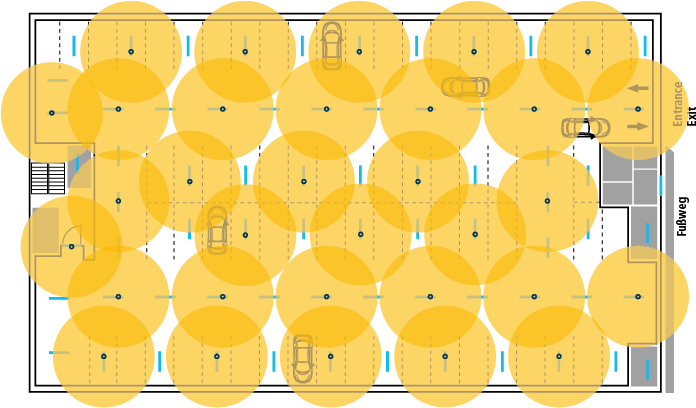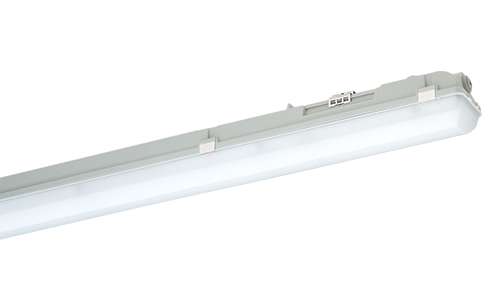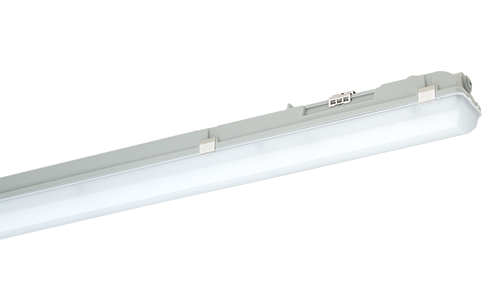LUXANO 2 in Sens & DIMC version –
smart, flexible, cost-efficient
The LUXANO 2 SENS & DIMC versions combine intelligent control with simple installation and high flexibility. Operating parameters such as output current, hold time, dimming ramp and automatic switch-off can be precisely configured via the integrated NFC interface. Only one additional phase is required for the control, which significantly reduces installation effort and costs.
Easy installation
| Economical operation
| Environmentally friendly and future-proof
|
Car park lighting
Sensor detection ranges
The smaller the detection area of a sensor, the more luminaires with sensors need to be installed. The sensor installed in the LUXANO 2 SENS has a very large detection area which, under ideal conditions, covers an area of approx. 80 m². An advantage that is reflected in significantly reduced investment costs.
Sensor detection ranges
|  |
Positioning of the lights with sensors – Variant 1: Complete area detection
With this variant, the aim is to achieve the widest possible coverage of the area by sensors. If the detection area of a sensor is entered, all DIMC luminaires assigned to the relevant SENS luminaire switch to 100% brightness. If a DALI light management system is used, flexible assignment of the luminaires is possible. In this example, the ratio of DIMC luminaires to SENS luminaires is approximately 1:1.
Luminaires
|  |
Positioning of the lights with sensors – Variant 2: Safety-related area detection
SENS luminaires are positioned at entrances and exits to the car park levels, in front of entrances and exits, above the carriageway and at the parking ticket machine. Continuous general lighting of 10 % provides orientation and increases the feeling of safety throughout the car park. It is therefore not necessary to cover the entire car park with sensors. Only every fourth luminaire requires a sensor (ratio 3:1) - this saves investment costs.
Luminaires
|  |
Planning example: Underground car park
Object data::
|
|
|
Luminaire parameters::
|
|
|
Example 1: Complete area detection
- 57x 167 15L60G2 DIMC, 6,000 lm, 43 W
- 32x 167 15L60G2 SENS, 5,810 lm, 36 W

The SENS luminaires are positioned directly above the carriageway, above the parking bays and at the stairwell access in order to achieve the widest possible detection of the areas.
Example 2: Safety-relevant area detection
- 74x 167 15L60G2 DIMC, 6,000 lm, 43 W
- 15x 167 15L60G2 SENS, 5,810 lm, 36 W

The SENS lights are positioned directly above the carriageway and at the stairwell access. The parking bays themselves are not covered by sensors.
Savings potential
The savings potential through the use of sensors is high. If we assume that the underground car park is almost constantly frequented over a period of 12 h during the day, but that significantly fewer movements are detected at night, it can be assumed that the operating time with 100 % light is 14 h (12 h during the day and 2 h at night). An operating time of 10 h is assumed for dimmed operation.
| Lighting system: conventional without sensors | LED lighting system: | ||||
| Example 1 | Example 2 | ||||
| DIMC luminaires | SENS luminaires | DIMC luminaires | SENS luminaires | ||
| Number | 89 | 57 | 32 | 74 | 15 |
| Output 100 % light | 110 W | 43 W | 36 W | 43 W | 36 W |
| Output 10 % dimming mode | 0 W | 6 W | 5 W | 6 W | 5 W |
| Operating time 100 % | 24 h | 14 h | 14 h | 14 h | 14 h |
| Operating time 10 % | 0 h | 10 h | 10 h | 10 h | 10 h |
| Power consumption * | 85,760 kWh/a | 20,244 kWh/a | 20,914 kWh/a | ||
| Electricity costs (€0.30/kWh) * | 25,728 €/a | 6,073 €/a | 6,274 €/a | ||
| CO2 equivalent* | 33 t/a | 8 t/a | 8 t/a | ||
* Data per calendar year
In a direct comparison of the two examples, the purchase costs for the luminaires in example 2 are approx. 10 % lower. Energy consumption, on the other hand, is slightly lower in example 1.
Car park lighting with LIMAS Line PRO light management system
The luminaires listed are also available as DIMD versions with a DALI 2 interface for operation with our LIMAS Line PRO light management system.
The use of LIMAS Line PRO offers the following advantages, among others:
|  |

